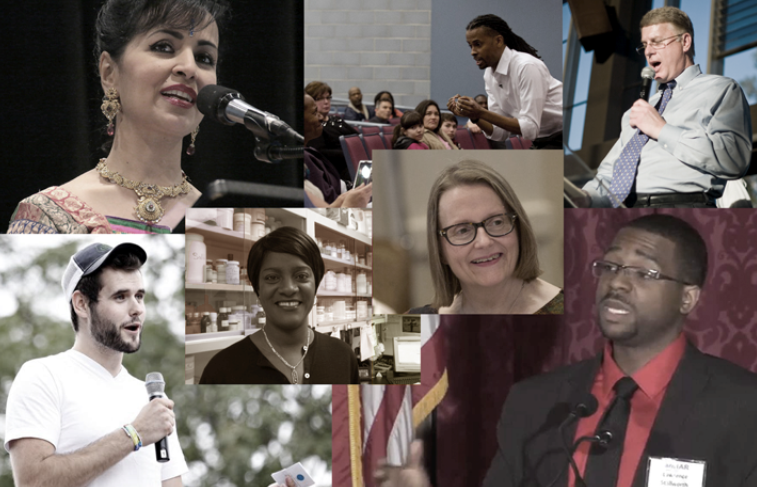Guest post by John Capecci, of Capecci Communications. John is co-author, with Tim Cage, of “Living Proof: Telling Your Story to Make a Difference,” and offers communication training, workshops, consulting and webinars on communication effectiveness.
If you work in nonprofit communications, marketing or development, you know that personal stories are invaluable when it comes to demonstrating your organization’s impact. They can often be the key that moves individuals from apathy to empathy to action.
That’s why we weave personal stories through our web copy, annual reports, fundraising videos and grant proposals. It’s also why we ask advocates to speak and tell their stories to the media and at fundraising and awareness events. Personal stories are powerful tools of advocacy—touching hearts, engaging imaginations and making abstract concepts concrete—especially when shared face to face. And practically every nonprofit at some point relies on someone who will stand up and speak his or her story.
As communication trainers and consultants for more than 20 years, Tim Cage and I have been honored to work with thousands of individuals—from “ordinary” people and first-time speakers to skilled presenters and media personalities— who are sharing their personal stories to advocate for causes or organizations they care about. Some speak in support of large and small nonprofits, or local and national groups. Others stand at lecterns, sit in circles and knock on doors. Still others are interviewed over the phone and on camera. But no matter where they’re from or how much (or how little) experience they have, these dedicated individuals from all walks of life share a common goal: to tell their own story with clarity, passion and purpose in order to make a real difference.
If you’ve witnessed the moment when an advocate’s story engages an audience’s hearts and minds, you know how powerful it can be. You may also know how disappointing, even uncomfortable, stories can be when they miss the mark and fall flat.
What makes the difference? Here are some key principles Tim and I have observed in smart organizations that are using personal stories as a successful part of their communications, marketing and development.
- Stories aren’t magic…unless they’re strategic.
Successful advocates and the organizations that rely on them know that advocating with a personal story is not a call to simply “Insert Story Here.” Personal stories touch hearts and encourage empathy, but they can’t do all the heavy lifting. Advocacy is an act of persuasion, so stories must be offered within a larger strategic framework.You don’t want your advocates to simply move an audience, you want them to move the audience to action—and that means appealing to both head and heart. Advocates and organizations are most effective when they link personal stories to key messages and proof points, when they consider the audience’s frame of reference and when they are clear in their intent. That’s when the magic happens. - There are more stories available than you think.
Every mission-driven organization benefits from having advocates tell their “Need and Benefit” stories. For example: the cancer patient who felt completely isolated until he found the welcoming and supportive community of Gilda’s Club Chicago, or the single mother in Mozambique who went from having no clean drinking water to building a bread-baking business that now supports her family, thanks to the work of charity: water.
Stories such as these are living proof of each organization’s mission and work. But organizations that are truly tapping the power of advocate stories know this: valuable stories can be found throughout their entire community of volunteers, staff, board members, leaders and funders. Those stories—“Why I Volunteer My Time,” “Why I Serve on this Board” or “The Moment I Knew We Were Making a Difference”—have just as much potential to connect with and move audiences as the stories of those we serve. The key lies in unearthing the stories “on the periphery”… and connecting them to the right audiences at the right time. - Advocates need support.
No matter how powerful a story is or how perfectly it conveys an organization’s message, the story will miss the mark with an audience if the advocate is not suitably prepared. Going public with a personal story is a significant decision for an individual and the most successful organizations understand that advocates need respectful and thoughtful support, including coaching, feedback and skill-building in public speaking and storytelling. The nonprofits we work with can’t stress enough how dedicating time and resources to their advocates has paid off for them—whether a national nonprofit leveraging support to provide training or a small local group making story-sharing and feedback part of every staff meeting.
Personal stories can make a difference. But it’s not by story alone that smart organizations and advocates urge others to take action, whether that action is donating money, improving public policy or changing behavior. Consider these three principles as you look ahead at unleashing the power of the stories in and around your organization.
Thank you to the advocates and organizations sharing their images in the above graphic:
Gayathri Ramprasad, Asha International
LeDerick Horne, lederick.com
Lawrence Stallworth II, President’s Council on HIV/AIDS
Carey Christensen, Michael J. Fox Foundation for Parkinson’s Research
Dina Piersawl, WomenHeart: The National Coalition for Women with Heart Disease
Zach Wahls, zachwahls.com and Scouts for Equality


 thedatabank, gbc is technology for change, and we walk the talk.
thedatabank, gbc is technology for change, and we walk the talk. 

